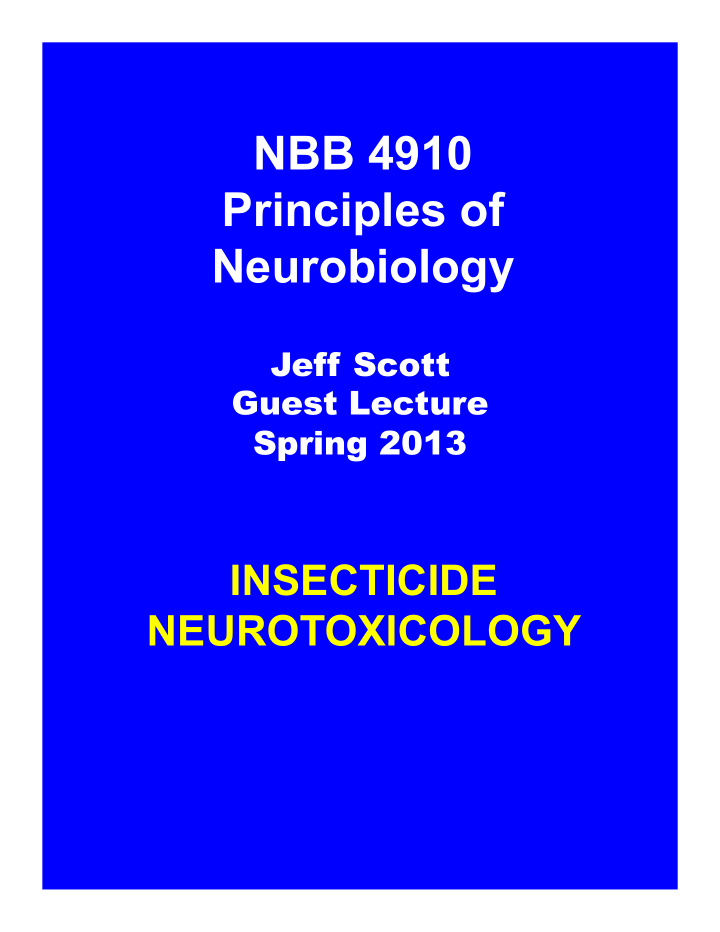



NBB 4910 Principles of Neurobiology Jeff Scott Guest Lecture Spring 2013 INSECTICIDE NEUROTOXICOLOGY
References Raymond-Delpuch, V., K. Matsuda, B. M. Sattelle, J. J. Rauh & D. B. Sattelle. 2005. Ion channels: molecular targets of neuroactive insecticides. Invert Neurosci 5: 119-133. Zlotkin, E. 2001. Insecticides Affecting Voltage-Gated Ion Channels In: Biochemical Sites of Insecticide Action and Resistance (I. Ishaaya ed) pp. 43-76. Springer-Verlag Berlin, Heidelberg.E. J. R. Bloomquist, 1996. Ion channels as targets for insecticides, Ann. Rev. Entomol. 41: 163-90. T. Narahashi, 1992. Nerve membrane Na + channels as targets of insecticides, Trends Pharmacol. Sci. 13: 236-241.
Pesticides
Historical Perspective Long, long ago Inorganics Long ago botanicals 1880 Commercial production (inorganics) 1941 DDT Effective insect control 1946 Cyclodienes 1947 Organophosphates 1950 Carbamates 1970 Insect Growth regulators 1980 Pyrethroids 1995 Genetic engineering 2000 Neonicotinoids
Historical Perspective In addition to pest control, neurotoxic insecticides have played key roles in characterization of the nervous system (e.g. DFP characterized serine in active site of AChE) Synthetic insecticides will continue to be a major factor for pest control into the foreseeable future.
Neurophysiology of insecticides acting on sodium channels DDT & Pyrethroids To investigate the mechanism of action of neurotoxins there are two main types of data one can gather: behavior and neurophysiology Usually both provide very useful information
HISTORY OF DDT H Cl C Cl CCl 3 ( D ichloro D iphenyl T richloroethane) • Synthesized in 1874 by Ziedler • Insecticidal activity discovered by Paul Muller of Geigy in 1939. Subsequently won the Nobel prize in 1948. • DDT opened the era of synthetic organic insecticides and "efficient" insect control. Called " miracle insecticide " or " the insecticide that won the war " in the mid 1940s. • Extremely effective against a broad range of insects (LD 50 1 ‑ 1000 ug/g to insects).
HISTORY OF DDT • Relatively safe to humans (oral LD 50 to humans 250 mg/kg, 115 mg/kg to rats, practically non ‑ toxic by dermal exposure). • Cheap !!!!!!! ~$0.50 per pound. • DDT has saved millions of lives. Controls vectors of diseases such as typhus, yellow fever or malaria . Use of DDT nearly eradicated malaria from the planet. Some areas still are malaria free while other have resurgence in the number of cases. • >2,000,000 tons of DDT have been manufactured (Mellanby 1992) • 1962 Silent Spring labels DDT the “Elixir of Death”
Military use of DDT
Civilian use of DDT
In In vi vivo vo pois poisoning oning sym symptom toms
American Cockroach CNS Cockroach cercal nerve-giant axon preparation
In In si situ tu pois poisoning oning sym symptom toms
Voltage Clamp
Voltage Clamp Normal
Voltage Clamp TTX
Voltage Clamp Normal vs. TTX
Voltage Clamp TEA
Voltage Clamp Normal vs. TEA
Voltage Clamp DDT
Voltage Clamp Normal vs. DDT
Voltage Clamp DDT + TEA
Voltage Clamp DDT alone vs.. DDT + TEA
Voltage Clamp DDT + TTX
Voltage Clamp TTX alone vs.. DDT + TTX
Do the voltage clamp experiments explain the repetitive discharges? Do repetitive discharges explain the symptoms?
Pyrethroids • Based upon a natural product ‑ pyrethrins • First pyrethroids synthesized in the 1940s, but they were not stable under field conditions. • Field stable pyrethroids discovered in the 1960s. • The 2nd largest class of insecticides in use today
Pyrethrins and the "early pyrethroids" Thes hese e ins insect ecticides icides appear ppear to o be be “s “super uper DDT” ” Sympt mptoms oms ar are e similar imilar Bot oth h caus cause e repet epetit itiv ive e dis dischar harges ges Bot oth h pr prolong olong the he opening opening of of the he sodium odium channel hannel Bot oth h ar are e mor more e toxic xic at lo lower er temper emperatur ures es VIDEO H H O = = Cl C Cl H C O CCl 3 H O DDT Pyrethrin I But then something unusual happened
Photostable pyrethroids Symptoms of poisoning are radically different from DDT or Type I pyrethroids VIDEO There are no repetitive discharges VIDEO
Structures of Type I and Type II pyrethroids Type I Type II O O O C O C N C O O CN Cl O fenvalerate tetramethrin CN O O O O C O C O phenothrin cyphenothrin CN O O O O Cl Cl C O C O Cl Cl cypermethrin permethrin
Identify the site of Action Type II Pyrethroids What would you do?
Patch clamp How does this explain the lack of repetitive discharges?
DDT and pyrethroids (both Type I and Type II) both hold the voltage gated sodium channel in the open state Differences in symptoms (and potencies) can be explained by differences in kinetics
Recommend
More recommend